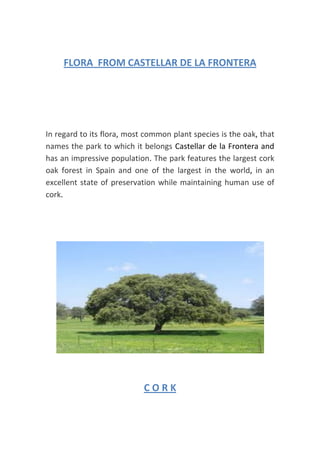Grupo 3
- 1. C astellar is a municipality with three urban cores. The Castle, Almoraima and new people, with a total population of approximately two thousand four hundred inhabitants. Runs through its territory Guadarranque River, in which the dam was built during the same name. This reservoir provides drinking water and irrigation to the people.
- 2. The mountains that surround it are rounded and of scanty altitude. Castellar lives of the agriculture with the exploitation of plots of irrigation. The water they comes supplied from a channel and in them it is cultivated principally citric. Nowadays one experiments on cultures under ceiling and tropical.
- 3. Something exists of ranching, principally in the estate of the Almoraima. It is a large estate of 16.000 hectares expropriated to Ruiz Mateo and that occupies mas of ninety per cent of the municipal territory. Because of its proximity to the sea, Castellar has a good climate. The winters are very mild. Rainfall is abundant in autumn and spring, which together with a constant humidity, make this area a huge Mediterranean forest. In the Mediterranean forest it abounds the blockheads, gall oaks and wild olive trees. Under them Mediterranean species coexist, as palmettoes, lentiscos, heathers and rockroses that coexist with the ferns that proliferate in the zones mas shady. There are ravines, called "canutos", in which there is a microclimate. As a result, we find species that have survived over millions of years and is currently in danger of extinction. CANUTO from CASTELLAR
- 4. In spring great quantity of wild flowers they cover the meadows, forming a multicolored carpet. This vegetation uses as cover and sustenance to a great number of insects, butterflies, spiders, mollusks, etc. Likewise these small animals feed to reptiles and amphibians to small mammals as the hedgehog. The deer, roe deer and sheep are the main representatives of mammals superiors. Due to its proximity to the African continent, this area is required for migratory birds as swifts, storks, abejarrucos and ducks. As the martin fisherman and some lads, they remain others in the zone all the year round.
- 5. FLORA FROM CASTELLAR DE LA FRONTERA In regard to its flora, most common plant species is the oak, that names the park to which it belongs Castellar de la Frontera and has an impressive population. The park features the largest cork oak forest in Spain and one of the largest in the world, in an excellent state of preservation while maintaining human use of cork. CORK
- 6. UNCORK IMAGES IN THE PARK OF CORK (Castellar)
- 7. Unlike the cork forests of other regions where the density is low, trees in this area are real forests accompanied by a rich and varied shrub and herbaceous vegetation in close connection, ensuring natural regeneration of forest, a good mix of ages, and a biodiversity of flora and fauna very high. But, plus cork, The Park has represented other important forests. Special mention forests of oak gall or Andalusian, from the past that make forests of indescribable beauty, where humidity is the star, with the trunks and branches colonized by lichens, mosses, ferns and some higher plants that climb in search of the necessary light is scarce at ground level because of the high density of the cover and the size reached by the leaves of this tree. OAK GALL
- 8. WILD FERMS It is also normal the presence of other species typical of Mediterranean forest the acebuche, the white poplar, the palmetto, and Pyrenean oak and madroño. ACEBUCHE ACEBUCHE SHEETS
- 9. WHITE POPLAR PALMITO MADROÑO TREE FRUIT PYRENEAN OAK
- 10. The terrain is relatively gentle hills leads a gallery forests of subtropical type that are unique in continental Europe, with presence of laurel, rhododendron, buckthorn, durum, alder, but this vegetation type occupied most of central and southern Europe during the Tertiary. LAUREL ALDER AVELLANILLO
- 11. FAUNA FROM CASTELLAR DE LA FRONTERA The rich fauna of the park also is determined largely by its geographic position. The position on the southernmost tip of Europe makes it required periodic passage, to and from África, of millions of migratory birds that converge in this area in search of seasonal food and a milder climate for development. Therefore, the Acorns Park is a paradise for birdwatchers, who come year after year to watch the passing mainly soaring birds: storks, kites, honey buzzard, booted eagle and toed, vultures, alimoche and a myriad of other birds that recover energy in the Park or hope that the weather conditions are favorable for the always problematic over the Strait of Gibraltar. CIGÜEÑA
- 12. MILANO HONEY BUZZARD VULTURE ALIMOCHE
- 13. Also important mammal populations for its variety and abundance. With a little luck, can be seen in the Acorns mongoose— Park preserves the largest European populations of this mongoose—, genets, otters, polecats, wildcats and weasels between carnivores and deer, ibex and deer between herbivores. CARNIVORUOS MAMMALS MONGOOSE GENET OTTER
- 14. POLECATS WILD CAT WEASEL
- 15. MAMMALS HERBIVORES IBEX ROE
- 16. These saws have the privilege of hosting the last population of deer called Andalusian Moorish race, in the southwestern limit of the global distribution of the species. Regarding the presence of the lynx, Current data are contradictory, but there may be some individuals in the most remote forests, far from human. DEER There are also quotes from the black spider.















